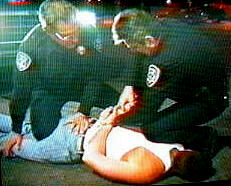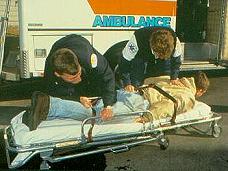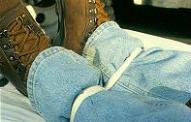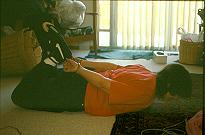


By Charly D. Miller
While updating content files for the next REPRINT of my EMT-B National Standards Self-Test, 3rd edition
textbook in January of 2011, I discovered that
Whether looking in Medical Dictionary textbooks or searching Medical Dictionary Internet websites, many restraint-related terms are, at BEST, insufficiently defined – IF their definition is even OFFERED!
After recovering from my flabbergasted SHOCK at this discovery [I couldn’t believe that, even in 2011, so-called experts have STILL failed to publish accurate definitions of these terms!!!], I quickly assembled and posted this webpage.
I hope you find it helpful!
YOURS, CHAS
[Ms. Charly D Miller]

MEDICAL TERMINOLOGY NOTE:
Because people with little-to-no medical education require this information just as much as medical professionals do, I have minimized the use of medical terminology and defined these terms/concepts as simply as possible. Any reader who is offended by the simplicity of my definitions can – er – seek this information elsewhere. (Good luck with that!)




 “PHYSICAL” Restraint
“PHYSICAL” Restraint
is most accurately defined as one or more human beings applying their HANDS (and/or other of their BODY PARTS) to an individual’s body, for the purpose of preventing that individual’s freedom of movement.

 
|
 In the past, the term “MECHANICAL Restraint” was usually used only when referring to METAL restraint devices – handcuffs, chains, ankle “shackles,” and the like. However, any DEVICE used for restraint (be it a roll of gauze, a towel or sheet, a plastic Zip Tie, a Velcro® or leather or fabric cuff/strap, and the like), is a “mechanical” form of restraint. In the past, the term “MECHANICAL Restraint” was usually used only when referring to METAL restraint devices – handcuffs, chains, ankle “shackles,” and the like. However, any DEVICE used for restraint (be it a roll of gauze, a towel or sheet, a plastic Zip Tie, a Velcro® or leather or fabric cuff/strap, and the like), is a “mechanical” form of restraint. |

|

A “PRONE” Position is defined as someone laying with the FRONT of their body on a surface.
A “SUPINE” Position is defined as someone laying with the BACK of their body on a surface.

[The terms PRONE and SUPINE are accurately defined in printed and Internet dictionaries.
I include them here only to be “complete.”]

 © 1997 BioguardianSystems,Inc |
FORCEFUL-PRONE-RESTRAINT” |
FORCEFUL-PRONE-RESTRAINT” |
 © 1997 Howard M. Paul |
Clearly, “PHYSICAL” and “MECHANICAL” forms of FORCEFUL-PRONE-RESTRAINT are relatively the same thing: Application of FORCE to an individual’s body while he is in a PRONE position, so as to prevent his movement out of the prone position.
I offer this definition distinction only in an effort to be completely “accurate.”

 © 1997 Howard M. Paul |
 © 1994 Michal Heron |
 © 1997 Howard M. Paul |
is universally (correctly!) defined as
|
 Photo Source = ? |

“POSITIONAL ASPHYXIA”
is most accurately defined as death that occurs because the POSITION of a person’s body interferes with respiration (breathing), and the person cannot get OUT of that position. Death occurs due to the person’s inability to BREATHE anymore.
 ANY position that obstructs the AIRWAY, OR that interferes with the muscular or MECHANICAL MEANS of getting air into and out of the body (the body’s abdominal “BELLOWS” function) will result in a positional asphyxia death, if the person cannot get out of it.
ANY position that obstructs the AIRWAY, OR that interferes with the muscular or MECHANICAL MEANS of getting air into and out of the body (the body’s abdominal “BELLOWS” function) will result in a positional asphyxia death, if the person cannot get out of it.
is a form of POSITIONAL ASPHYXIA!  The factor that distinguishes a “restraint asphyxia” death from a “positional asphyxia” death, is that some form of RESTRAINT is the reason the Victim couldn’t ESCAPE the asphyxiating position. The factor that distinguishes a “restraint asphyxia” death from a “positional asphyxia” death, is that some form of RESTRAINT is the reason the Victim couldn’t ESCAPE the asphyxiating position. First proposed in 1993, the phrase “Restraint Asphyxia” has become more widely-adopted since 1998.(1,2) Yet, several other phrases continue to be used when referring to incidents of restraint asphyxia: “Mechanical Asphyxiation,” “Traumatic Asphyxiation,” “Sudden In-Custody Death,” and the like. First proposed in 1993, the phrase “Restraint Asphyxia” has become more widely-adopted since 1998.(1,2) Yet, several other phrases continue to be used when referring to incidents of restraint asphyxia: “Mechanical Asphyxiation,” “Traumatic Asphyxiation,” “Sudden In-Custody Death,” and the like. |
 2004 PPt Slide, C.D.Miller |
Why is this Restraint Asphyxia vs Positional Asphyxia
Definition Distinction IMPORTANT?
When unrelated to restraint, Positional Asphyxia deaths are deaths caused by the “passive entrapment” of an individual – no “person” is responsible for the Victim being unable to escape the asphyxiating position. Thus, the “manner of death” historically assigned to Positional Asphyxia deaths by medical examiners and forensic pathologists has always been “ACCIDENTAL.”
 Since 1994, however, educated medical examiners and forensic pathologists have officially recognized Restraint-Related forms of Positional Asphyxia deaths as being quite different from ACCIDENTAL deaths.
Since 1994, however, educated medical examiners and forensic pathologists have officially recognized Restraint-Related forms of Positional Asphyxia deaths as being quite different from ACCIDENTAL deaths.
 Restraint-Related Positional Asphyxia deaths are ALWAYS caused by PEOPLE having acted to physically or mechanically entrap someone in an ASPHYXIATING POSITION.(3-4) Thus, since 1994, the correct “manner of death” assignment for Restraint Asphyxia deaths is now recognized as being, “HOMICIDE.”(5-7)
Restraint-Related Positional Asphyxia deaths are ALWAYS caused by PEOPLE having acted to physically or mechanically entrap someone in an ASPHYXIATING POSITION.(3-4) Thus, since 1994, the correct “manner of death” assignment for Restraint Asphyxia deaths is now recognized as being, “HOMICIDE.”(5-7)

REFERENCES
ALL references cited above and listed below can be found in Charly’s
RESTRAINT ASPHYXIA LIBRARY!
(1) O'Halloran RL, Lewman LV. Restraint asphyxiation in excited delirium. Am J Forensic Med Pathol, 1993;14(4):289-295.
(2) Reay DT. Death in custody. Clin Lab Med, 1998 Mar;18(1):1-22.
(3) Hirsch CS: Letter to the editor RE: Restraint asphyxiation in excited delirium & the article authors' reply. Am J Forensic Med Pathol, 1994;15:266.
(4) O'Halloran RL, Frank JG: Asphyxial death during prone restraint revisited: A report of 21 cases. Am J Forensic Med Pathol, 2000;21(1):39-52.
(5) Hanzlich R, Hunsaker JC, Davis GJ. National Association of Medical Examiners’ guide for manner of death classification; First edition. Approved by NAME Board of Directors, February 2002.
(6) Wecht CH. Response to the National Association of Medical Examiners position paper on the certification of cocaine-related deaths. Am J Forensic Med Pathol, (December) 2004;25: 362-363.
(7) Miyaishi S, Yoshitome K, Yamamoto Y, et al. Negligent homicide by traumatic asphyxia. Int J Legal Med, Jan 14 2004.


 Email Charly at: chas@novelholiday.com
Email Charly at: chas@novelholiday.com